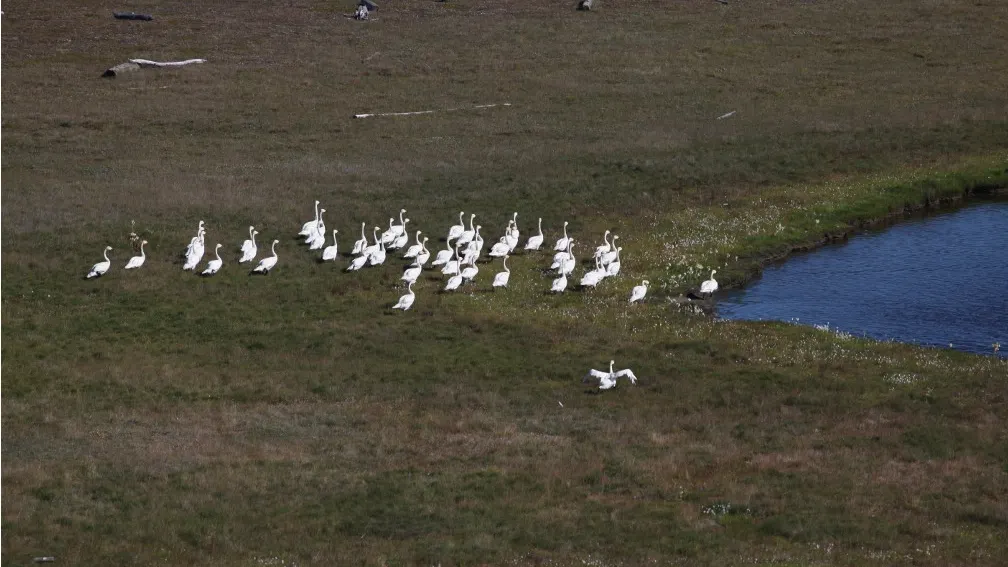0
0
Swans of Yamal turned out to be Asians. They are sending signals to scientists
Scientists analyze the signals of 14 GSM transmitters, with which Bewick’s swans (or tundra swans) were marked on Levdiev Island in the Kara Sea in summer of 2019. In November the data from the birds came from Northern Kazakhstan, Turkey, Ukraine, Bulgaria, Krasnodar Krai, Crimea, Chechnya and Volgograd Oblast. Thus, new migration routes of the rare swans building nests in Yamal-Nenets Autonomous Okrug were established.
Since 2015 the region has been implementing the project on study of Bewick’s swans to define their conservation status. In the arctic zone there are two populations - prosperous Asian and endangered North-European. The population of the latter, according to records on wintering on the North Sea coast in Europe, has decreased by more than 40 percent since 1995. The scientists are trying to find out the reasons for this decrease, as the department of external relations of Yamal-Nenets Autonomous Okrug informs.
In the course of the studies it was found out that the Bewick’s swans living in Yamal in the Baydaratskaya Bay belong to the prosperous Asian population that does not require special conservation status. More than 30 birds tagged in different years migrated to southeastern China, Central Asia, the Black Sea coastal area and the Caspian Sea. None of them went to Europe for winter. The scientists still receive the data from one of the swan females tagged in 2016. The bird was nicknamed “Zvyozdochka” (Little Star), as several times it was caught into the lenses of cameras in Kazakhstan and China. It is now wintering on Lake Poyang in China.
In 2019 the scientists of Severtsov Institute of Ecology and Evolution of the Russian Academy of Sciences with support of the Russian center for the Arctic exploration conducted the expedition to the west from the Baydaratskaya Bay, on Levdiev Island (Yamal-Nenets Autonomous Okrug) and in the Khaypudyrskaya Bay (Nenets Autonomous Okrug). The Bewick’s swans building nests on these territories were marked with colored collars and GSM transmitters provided by the research center for eco-environmental sciences of the Chinese Academy of Sciences within the project on joint research on remote tracking of migratory birds in Yamal-Nenets Autonomous Okrug and Nenets Autonomous Okrug, Russia.
10 swans tagged in Khaypudyrskaya Bay also turned out to be of Asian origin. They crossed the Urals and then flew south along the Ob River, making a significant detour to the Central European, the Black Sea and Caspian wintering grounds, what indicates their Asian origin. In Romania and Bulgaria the swans tagged in Khaypudyrskaya Bay were photographed by bird fanciers.
“The North-European population of the Bewick’s swan continues to decrease against the background of growth in number of Asian populations”, candidate of biological sciences, a researcher at Severtsov Institute of Ecology and Evolution of the Russian Academy of Sciences Sophia Rosenfeld commented. – “The research shows that Bewick’s swans of Asian origin took the territory to the west from the Ural Mountains and reached the nesting center of the endangered North-European population”.
As it should be added, 143 individuals of the Bewick’s swan have been ringed since 2015, and 57 birds of them were tagged with transmitters. Owing to the conducted research, 4 previously unknown migration routes and 8 new wintering grounds were discovered.
Photos can be found here: https://sever-press.ru/2019/12/12/jamalskie-lebedi-okazalis-aziatami-oni-shljut-uchenym-signaly/
0
0
Теги:
